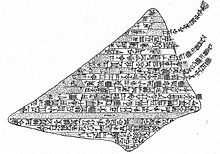Enlil-nadin-ahi
| Enlil-nādin-aḫe | |
|---|---|
| King of Babylon | |
 | |
| Reign | 1157—1155 BC |
| Predecessor | Zababa-šuma-iddina |
| Successor |
Marduk-kabit-aḫḫēšu 2nd Dynasty of Isin |
| Royal House | Kassite |
Enlil-nādin-aḫe,[nb 1] “Enlil gives a brother,”[nb 2] or Enlil-šuma-uṣur, “Enlil protect the son,”[nb 3] depending on the reading of –MU-ŠEŠ,[1] ca. 1157—1155 BC (short chronology), was the 36th and final king of the Kassite or 3rd dynasty that had ruled over Babylon and the land known as Karduniash since perhaps around 1500 BC.
Biography
Shutruk-Nahhunte, king of Elam, had overrun Babylonia bringing Enlil-nādin-aḫe’s predecessor, Zababa-šuma-iddina’s brief rule to an end. He had then returned to Susa leaving his son, Kutir-Nahhunte, to govern. Enlil-nādin-aḫe was proclaimed king of “Sumer and Akkad”, and ruled for three years[i 2] possibly in defiance of the occupying Elamite forces.[2] A single kudurru, or boundary stone (pictured), detailing a royal land grant,[i 1] an administrative text listing recipients of grain from Ur,[i 3] and a couple of tablets from a small cache[i 4] from the Merkes section of Babylon, all bear witness to his reign.[3]
According to later chronicles, his short reign was brought to a dramatic close when he led a campaign against the Elamite forces and suffered a crushing defeat at the hands of Kutir-Nahhunte, who was possibly now the successor of Shutruk-Nahhunte. He was deported with the Kassite noblemen in chains to Susa accompanied by the booty pillaged from the various Babylonian temples, whose most notable example was the cult statue of Marduk,[4] an act so sacrilegious to the Babylonians that it would forever cast Kutir-Nahhunte in infamy.
His crimes were greater and his grievous sins worse than all his fathers had committed. . .like a deluge he laid low all the peoples of Akkad, and cast in ruins Babylon and all the noblest cities of sanctity.[2]
The memory of the disaster was preserved in the Akkadian liturgy in a prayer, presenting rituals in the third month Simanu. An invocation for the god of justice, Šamaš, recounts:
An aggressor attacked us, plundered our flocks. A wicked enemy came quickly against us; the evil one laid waste our countryside. The foe captured us. His bow was nocked to let the arrows fly. But we ourselves, we did not know how to grasp a quiver. Elam overwhelmed our sacred localities. We did not know the great craft of war and the Subarian [was as] hostile to him as a ewe-lamb. Babylon, its loins have been stripped.[5]
The oblique mention of the Subarian in all likelihood refers to the Assyrian king.
The so-called Chedor-laomer texts, from the Spartoli tablets collection in the British Museum, may make reference to this period, where Kutir-Nahhunte is represented by Kudur-lagamar.[6] Kudur-lagamar is described as ruling in Babylon and overthrowing, or perhaps taking away Marduk. These are fragmentary second century BC texts, preserving traditions going back to perhaps the seventh century BC, relating how four successive kings, with cryptic ambiguous names, attacked Babylon.[7]
The Marduk Prophecy,[i 7] a vaticinium ex eventu (prophesy after the fact) composition of perhaps the Nabu-kudurri-uṣur I-(Nebuchadnezzar I) reign, ca. 1125 BC to 1103 BC, describes the dire consequences of the departure of the statue of Marduk, on the city of Babylon, where: “mad dogs roam the city biting citizens, friend attacks friend, the rich beg from the poor, brother eats brother, and the corpses block the city gates.”[8]
Inscriptions
- ↑ 1.0 1.1 Kudurru BM 113891 in the British Museum.
- ↑ Kinglist A, BM 33332, column 2, line 15.
- ↑ Tablet Museum reference, IM 85538, excavation reference U 7789i, “Issues of Grain.”
- ↑ Tablets VAT 13230 and VAT 21995, although the latter lacks the last element of the name.
- ↑ Tablet K. 2660, pseudo-autobiography of Nabû-kudurrī-uṣur.
- ↑ Tablet BM 32656, column 3, lines 13 to 20.
- ↑ The Marduk Prophecy (Prophecy D, tablet K. 2158+.
Notes
References
- ↑ J. A. Brinkman (1976). "Enlil-nādin-aḫe". Materials for the Study of Kassite History, Vol. I (MSKH I). Oriental Institute of the University of Chicago. pp. 122–124.
- ↑ 2.0 2.1 D. J. Wiseman (1975). "XXXI: Assyria and Babylonia, 1200-1000 B.C.". In I. E. S. Edwards. Cambridge Ancient History, Volume 2, Part 2, History of the Middle East and the Aegean Region, c. 1380-1000 BC. Cambridge University Press. pp. 446, 487.
- ↑ L. Sassmannshausen (2006). "Zur mesopotamischen Chronologie des 2. Jahrtausends". Baghdader Mitteilungen 37: 168.
- ↑ Elizabeth Carter, Matthew W. Stolper (1985). Elam: surveys of political history and archaeology. University of California Press. p. 40.
- ↑ A. R. George (2000). "Four Temple Rituals from Babylon: 2. Simanu". In Wilfred G. Lambert, A. R. George, Irving L. Finkel. Wisdom, Gods and literature: studies in Assyriology in honour of W.G. Lambert. Eisenbrauns. pp. 270–280.
- ↑ Hindel, Ronald (1994). "Finding Historical Memories in the Patriarchal Narratives". Biblical Archaeology Review 21 (4): 52–59, 70–72.
- ↑ K. A. Kitchen (2003). On the reliability of the Old Testament. Wm. B. Eerdmans. p. 569.
- ↑ Matthew Neujahr (2006). "Royal Ideology and Utopian Futures in the Akkadian Ex Eventu Prophecies". In Ehud Ben Zvi. Utopia and Dystopia in Prophetic Literature. Helsinki: The Finnish Exegetical Society, University of Helsinki. pp. 41–54.